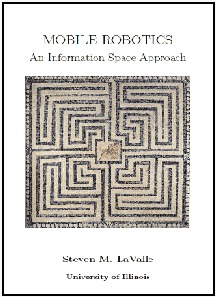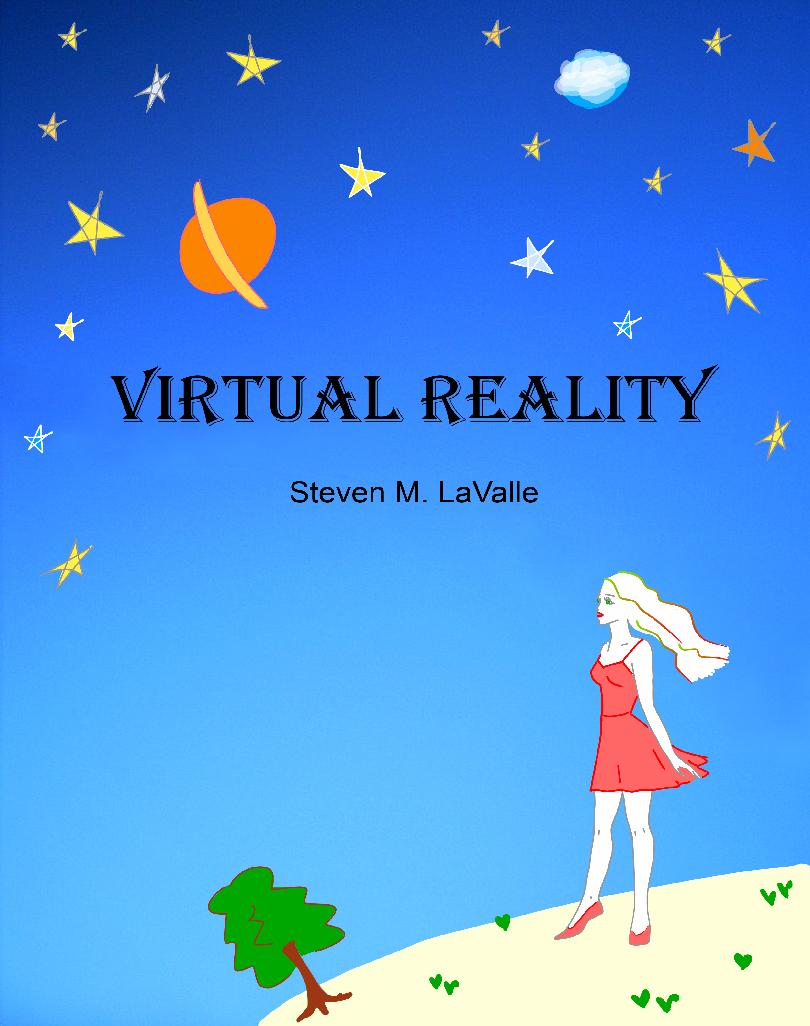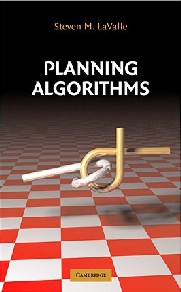Completed Books
Cambridge University Press, 2023.
See the Virtual
Reality page to download a FREE COPY.
This book covers the fundamentals of virtual reality systems, including geometric modeling, transformations, graphical rendering, optics, the human vision, auditory, and vestibular systems, interface design, human factors, developer recommendations, and technological issues. The material grew from courses Steve LaValle and Anna Yershova taught at UIUC and IIT Madras.
You are welcome to download and print out the whole manuscript for
your own use.
Cambridge University Press, 2006, 842 pages.
To buy a hard copy:
Cambridge
Amazon
Kinokuniya
See the Planning
Algorithms page to download a FREE COPY.
Also available in Chinese!
This book presents a unified treatment of many different kinds of planning algorithms. The subject lies at the crossroads between robotics, control theory, artificial intelligence, algorithms, and computer graphics. The particular subjects covered include motion planning, discrete planning, planning under uncertainty, sensor-based planning, visibility, decision-theoretic planning, game theory, information spaces, reinforcement learning, nonlinear systems, trajectory planning, nonholonomic planning, and kinodynamic planning. The material grew from courses LaValle taught at UIUC, Stanford, and Iowa State.
You are welcome to download and print out the whole manuscript for
your own use.
 Sensing and Filtering
Sensing and Filtering
A Fresh Perspective Based on Preimages and Information Spaces
Now Publishers Inc., 2012, 134 pages.
To buy a hard copy:
Now Publishers
Amazon
Here is a full, FREE draft.
Where do robots get their information? For a given task, what
information is actually necessary? What is even meant by
"information"? These questions lie at the heart of robotics and fall
under the realm of sensing and filtering. In Sensing and Filtering,
the author presents an unusual view of these subjects by
characterizing the uncertainty due to the many-to-one mappings between
the world and sensor readings. This is independent of noise-based
uncertainty and reveals critical structure about the possible problems
that can be solved using specific sensors. The set of all sensor
models is arranged into a lattice that enables them to be compared for
purposes of interchangeability. Filters, which combine sensor
observations, are expressed in terms of information states (not
information theory), a concept that was introduced in decision and
control theory. Sensing and Filtering provides the reader with
modeling tools and concepts for developing robotic systems that
accomplish their tasks while carefully avoiding the reconstruction of
unnecessary state information. This is in contrast to the approach
usually taken in planning and control, which is to fully reconstruct
and maintain the state at all times. The new approach may enable
simple, robust, and inexpensive solutions to tasks such as navigation,
topological mapping, coverage, patrolling, tracking, and
pursuit-evasion.
Incomplete or Ongoing Book Projects
 Mobile Robotics
Mobile Robotics
An Information Space Approach
This book was started in 2012 and was intended to be completed in 2013 during a wonderful sabbatical in Oulu, Finland. However, I unexpectedly became an early founder of Oculus VR, which derailed this book plan. Perhaps it will continue again some day, or a different, similar book might emerge.
Download a draft of Chapter 1: Introduction. Last update: 8 Jan 2013.
Download a draft of Chapter 2: Movable Machines. Last update: 8 Jan 2013.
Download a draft of Chapter 3: Sensing. Last update: 6 Feb 2013.
Download a draft of the Table of Contents (subject to change).

